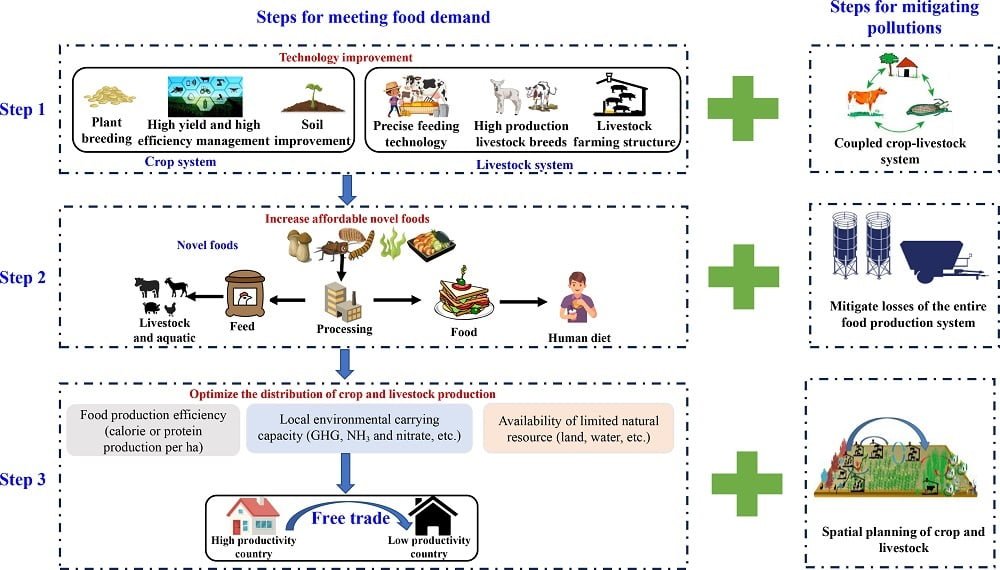
Our current food system, designed for the mid-20th century, faces a significant challenge: feeding a growing population with diverse needs while also safeguarding the environment. While global food security has improved, millions of people still suffer from hunger, and hidden hunger (micronutrient deficiencies) poses a silent threat to health.
The global food system is at a critical juncture, facing a confluence of challenges and opportunities that demand profound transformation. Transforming the food system can improve access to nutritious and affordable foods for vulnerable populations and enhance global food security.
Researchers from Nanjing University, Hebei Agricultural University, and Hebei University of Science and Technology presented a comprehensive review and proposed a three-step strategy for future agricultural development based on food security, quality, and environmental aspects.
Despite advancements, 828 million people worldwide suffer from hunger, and over two billion suffer from hidden hunger.
- Hidden hunger, lack of essential micronutrients despite having sufficient calories, often related to inadequate protein intake, has serious health consequences.
- Protein deficiency is a significant concern, especially for children in developing regions. Animal-sourced protein offers a solution, but its production puts pressure on the environment, leading to deforestation, greenhouse gas emissions, and water scarcity.
Addressing people’s hidden hunger is crucial for achieving the UN SDGs, especially SDG 2.
The solution: a three-step transformation with integrated technologies
Professor Lin Ma from Nanjing University and his team proposed a three-step approach to transform the food system by integrating various novel technologies. Transforming our food system requires a multi-faceted approach, integrating several technologies:
Step 1: Addressing hunger and reducing pollution
The first step should focus on addressing people’s caloric needs, essential for achieving Zero Hunger SDG. Efforts to address caloric needs should combine crop and livestock cycles to reduce environmental pollution during the food production process.
This step includes:
- Boosting crop yields: For the cropping system, based on various limiting factors in each country, such as soil fertility, arable land areas, and irrigation capacities, a quantitative analysis is conducted to determine the maximum yield potential and crop efficiency potential in each country. Subsequently, along with relevant policy guidelines related to food production in each country, corresponding technical optimization is recommended, such as seed improvement, field recovery, and better management practices, to increase crop yields. Technologies like China’s Science and Technology Backyard platform can significantly increase small farmers’ yields. For the livestock system, each country should improve meat production by optimizing feed structure and high-yielding livestock breeds to improve feed conversion rates.
- Sustainable practices: Integrated soil and crop management systems improve average crop yields while also reducing pollution. In terms of the environment, a coupled crop-livestock system can be recommended to reduce environmental pollution and promote green agricultural development.
Step 2: Prioritizing proteins and mitigating emissions
It should consider people’s demand for high-quality proteins, allowing the transition from simply eating enough to eating well. At this stage, emission reduction technologies should be introduced to reduce environmental pollution during the food production process.
- Dietary changes: Promoting a “flexitarian” approach (more plant-based meals) can reduce environmental impact while still providing enough protein.
- New protein sources: Research into insects, algae, and other sustainable protein sources holds promise for the future.
- Emission reduction technologies: Technologies for better fertilizer application, manure management, and recycling can significantly reduce agricultural emissions.
Step 3: Achieving efficiency and sustainability
The third step is to improve global food production efficiency and environmental sustainability, ensuring that natural resource consumption and environmental emissions associated with food production remain within planetary boundaries.
Additionally, the study proposes optimizing global trade and spatial planning techniques to further enhance food production and environmental efficiency, ensuring the achievement of both global SDG goals and AGD objectives.
Firstly, this step involves establishing classification criteria for various countries worldwide, including food production efficiency, environmental thresholds, and natural resource constraints. Then, countries are globally classified into high food production efficiency and low food production efficiency based on established classification criteria. Additionally, countries are classified in terms of their environmental impact, distinguishing between nations with high and low pollution.
Ultimately, it should encourage countries with high food production efficiency to maximize food production within the limits of environmental and natural resource thresholds and export to countries with low food production efficiency, thereby improving global resource efficiency.
The future of food: diverse, nutritious, and sustainable
We can create a future food system that meets diverse needs by implementing this three-step plan and integrating various technologies. We can eradicate hunger, ensure access to high-quality proteins, and achieve environmental sustainability. This will require collaboration among researchers, policymakers, farmers, and consumers to build a future where everyone has access to nutritious food produced in harmony with the planet.
Contact
Zhaohai BAI
State Key Lab Pollution Control & Resource Reuse, School of Environment, Nanjing University
Nanjing 210023, China
Email: baizh1986@126.com
Lin MA
State Key Lab Pollution Control & Resource Reuse, School of Environment, Nanjing University
Nanjing 210023, China
Email: malin1979@nju.edu.cn
Reference (open access)
Xiangwen FAN, Xiaomeng ZHANG, Xiaofei WU, Wenqi MA, Zhaohai BAI, Lin MA. Toward sustainable food systems: global initiatives and innovations. Front. Agr. Sci. Eng., 2024, 11(1): 197‒209 https://doi.org/10.15302/J-FASE-2024544
Editor and founder of “Innovar o Morir” (‘Innovate or Die’). Milthon holds a Master’s degree in Science and Innovation Management from the Polytechnic University of Valencia, with postgraduate diplomas in Business Innovation (UPV) and Market-Oriented Innovation Management (UPCH-Universitat Leipzig). He has practical experience in innovation management, having led the Fisheries Innovation Unit of the National Program for Innovation in Fisheries and Aquaculture (PNIPA) and worked as a consultant on open innovation diagnostics and technology watch. He firmly believes in the power of innovation and creativity as drivers of change and development.





